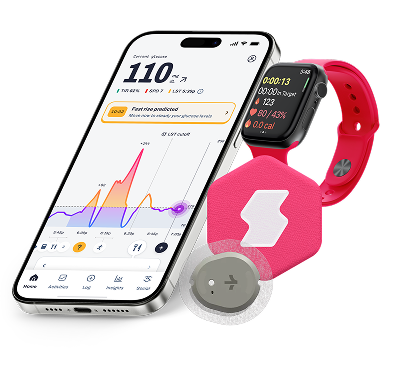Corn, also known as maize, has been a staple crop in North American agriculture for hundreds of years. It is drought resistant, easy to grow, and versatile in cooking. The main variety we consume is sweet corn, which offers a range of nutrients and fiber.
Americans consume the largest amount of corn and corn by-products in the world.¹ In 2019, it was estimated that each person consumed 36.5 lbs of corn products yearly. This is a significant increase from data thirty years ago, documenting approximately 21 lbs consumed per person.
This article will explore how corn may impact blood sugar levels and the health benefits that could be gained from including this vegetable in meals.
Sign up to be the first to know about special offers and exciting Signos news.
Glycemic Index Table
Corn contains natural carbohydrates, which are broken down into simple sugars during digestion. Sugars from food are absorbed into your bloodstream and can raise your blood sugar levels.
Corn alone may not cause your blood sugars to spike, as it is considered a low glycemic index food, but when you consider the full glycemic load of your meal, there is a good chance you may see a spike. It is common to serve corn alongside other high-starch and high-carb foods, which all accumulate and can raise blood sugar levels.
Every person will have a unique glycemic response to corn. Some people may experience higher blood glucose levels, and others may not. The below glycemic index and glycemic load data are based on a serving size of 100g (approximately one medium cob) of sweet, yellow, raw corn.² ³

Nutritional Facts
Corn is a robust source of energy, vitamins, minerals, and fiber while low in sodium and fat. While there are natural sugars in corn, positive nutritional properties make it a safe option to include in meals.
Nutritional Facts

Is Corn Good for Weight Loss?
Unprocessed versions of corn can be part of your weight loss journey. The bright, juicy kernels are high in fiber and have a variety of minerals and vitamins.
What you pair corn with will significantly influence its nutritional value. Try to pair corn with fresh, non-starchy vegetables, spices, and lean proteins.
You will want to avoid processed foods containing corn, which could hinder your weight loss. These foods often have a higher glycemic index than raw corn, including corn chips, corn tortillas, high-fructose corn syrup, and corn starch.
Is Corn Safe for People Living with Diabetes?
Corn, a low glycemic index food on its own, is safe for people living with diabetes. When included in processed foods, the glycemic index of corn can be significantly raised, so individuals should be mindful of portion sizes.
The American Diabetes Association classifies corn as one of the best starchy vegetables to choose from when planning meals. However, this vegetable should make up only a quarter of your plate.⁹ You can balance this starchy vegetable with lean proteins and healthy fats.
Similar to rice, the cooking method of corn will also influence its glycemic index. The ideal cooking method is boiling, which will decrease the GI score of this vegetable. If you want to eat popcorn, a popular corn variety, purchase plain popcorn and avoid adding extra butter, cheese, caramels, or oils.
Better health starts here.
Sign up for tips and insights that work for you!
Allergies
Corn allergies can be caused by an immune system reaction to the proteins found in corn. Symptoms of an allergic reaction to corn include:
- Digestive issues: nausea, vomiting, diarrhea, abdominal pain, or bloating
- Skin reactions: itching, hives, swelling of the lips, tongue, or throat
- Respiratory symptoms: sneezing, running nose, nasal congestions, wheezing, or difficulty breathing
In severe cases, an allergic reaction can lead to anaphylaxis, which is a life-threatening situation.
If you suspect an allergy to corn, please consult a healthcare professional.

References
References
- USDA Economic Research Service. (2022, June 30). USDA ERS - Feedgrains Sector at a Glance. Feedgrains Sector at a Glance. Retrieved June 2023, from https://www.ers.usda.gov/topics/crops/corn-and-other-feedgrains/feedgrains-sector-at-a-glance/
- The University of Sydney. (2023, May 1). Glycemic Index – Glycemic Index Research and GI News. https://glycemicindex.com/
- USDA FoodData Central. (2019, April 1). Food Details - Corn, sweet, yellow, raw. Retrieved from https://fdc.nal.usda.gov/fdc-app.html#/food-details/169998/nutrients
- Siyuan, S., Tong, L., & Liu, R. (2018). Corn phytochemicals and their health benefits. Food Science and Human Wellness, 7(3), 185-195. https://doi.org/10.1016/j.fshw.2018.09.003
- Buscemi S, Corleo D, Di Pace F, Petroni ML, Satriano A, Marchesini G. The Effect of Lutein on Eye and Extra-Eye Health. Nutrients. 2018 Sep 18;10(9):1321. doi: 10.3390/nu10091321. PMID: 30231532; PMCID: PMC6164534.
- Bernstein PS, Li B, Vachali PP, Gorusupudi A, Shyam R, Henriksen BS, Nolan JM. Lutein, zeaxanthin, and meso-zeaxanthin: The basic and clinical science underlying carotenoid-based nutritional interventions against ocular disease. Progress in Retinal and Eye Research. 2016 Jan;50:34-66. doi: 10.1016/j.preteyeres.2015.10.003. Epub 2015 Nov 2. PMID: 26541886; PMCID: PMC4698241.
- Line Q. Bendtsen and others, Effect of Dairy Proteins on Appetite, Energy Expenditure, Body Weight, and Composition: a Review of the Evidence from Controlled Clinical Trials, Advances in Nutrition, 4(4), July 2013, Pages 418–438, https://doi.org/10.3945/an.113.003723
- Kljak K, Grbeša D. Carotenoid content and antioxidant activity of hexane extracts from selected Croatian corn hybrids. Food Chemistry. 2015 Jan 15;167:402-8. doi: 10.1016/j.foodchem.2014.07.002. Epub 2014 Jul 9. PMID: 25149004
- American Diabetes Association. Get Smart On Carbs. (n.d.). https://diabetes.org/healthy-living/recipes-nutrition/understanding-carbs




.svg)
.svg)
.svg)
.svg)
.svg)
.svg)
.svg)
.svg)
